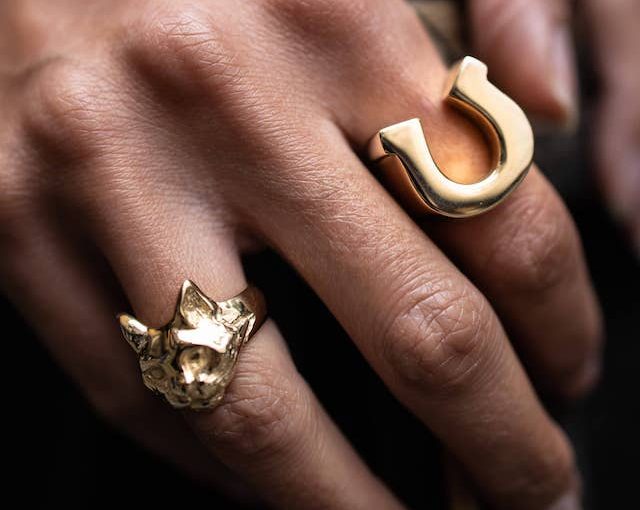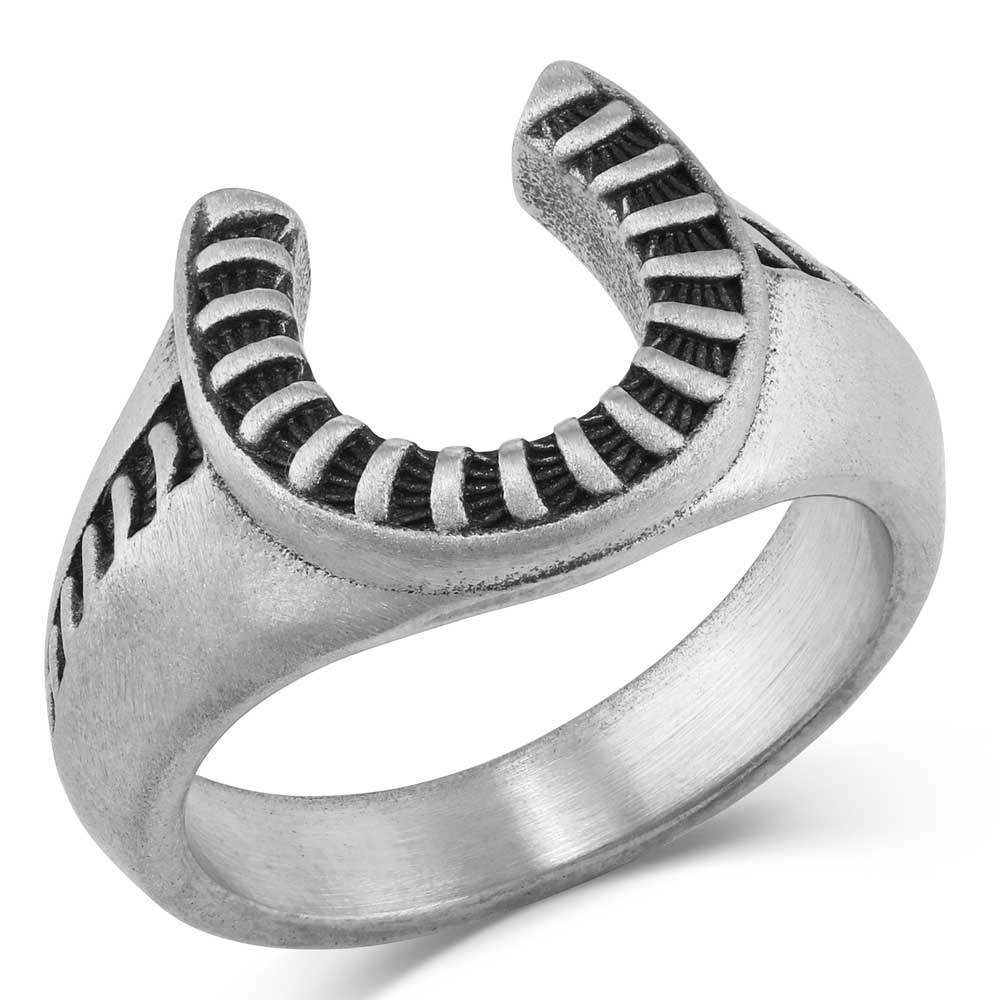Introduction
The horseshoe has long been a symbol of good luck and protection, and its use in jewelry dates back centuries. In particular, the horseshoe rings have become a popular choice for those seeking to channel the positive energy associated with this iconic emblem. In this article, we will delve into the history and symbolism behind the horseshoe rings, as well as explore its significance in different cultures and traditions.
Part 1: The History of Horseshoe Rings
Level 1: Ancient Origins
The practice of nailing iron horseshoes to horses’ hooves is believed to have originated during the Roman Empire. This technique was thought to protect the horse’s feet and bring good luck to the animal and its owner. As the use of horseshoes spread throughout Europe and beyond, the symbol of the horseshoe became associated with good fortune and protection.
Level 2: Evolution of Horseshoe Rings
The transition from horseshoes being solely associated with horses to being worn as jewelry is believed to have occurred during the medieval period. Horseshoe rings in various forms began to emerge, often featuring intricate designs and embellishments. Over time, the horseshoe rings evolved to become a popular choice for both men and women, as its symbolism of luck and protection remained highly valued.
Part 2: Symbolism of the Horseshoe Ring
Level 1: Good Luck and Protection
The crescent shape of the horseshoe, resembling the moon, represents fertility and abundance. Additionally, the act of hanging a horseshoe with its ends pointing upwards is thought to ward off evil spirits and bring positive energy into the home.
Level 2: Cultural Significance
The symbolism of the horseshoe ring varies across different cultures. In some traditions, the horseshoe is seen as a talisman for fertility and prosperity. In others, it is associated with warding off the evil eye and bringing good fortune. The horseshoe ring has transcended cultural boundaries, becoming a universally recognized symbol of luck and protection.
Part 3: The Horseshoe Ring in Fashion
Level 1: Timeless Appeal
The horseshoe ring has maintained its popularity in the world of fashion, enduring as a timeless and versatile piece of jewelry. Its association with luck and protection makes it a meaningful accessory for those seeking to add a touch of symbolism to their personal style.
Level 2: Modern Interpretations
Contemporary jewelry designers have reimagined the horseshoe ring, incorporating innovative materials and designs to appeal to a wide range of tastes. From minimalist and understated pieces to bold and elaborate creations, the horseshoe ring continues to captivate the imagination of jewelry enthusiasts around the world.
Part 4: Horseshoe Rings in Different Cultures
Level 1: European Traditions
In many European cultures, the horseshoe is deeply ingrained in folklore and superstition. The tradition of hanging a horseshoe above the doorway to bring good luck and protection is still observed in many households. The horseshoe rings is also a popular choice for engagement and wedding bands, symbolizing the hope for a prosperous and blessed union.
Level 2: Eastern Symbolism
In Eastern cultures, the horseshoe holds its own significance. In some traditions, the horseshoe is seen as a protective charm that wards off negative energy. It is often incorporated into jewelry, including rings, as a symbol of fortune and well-being.
Part 5: The Appeal of Horseshoe Rings Today
Level 1: Personal Meaning
For many individuals, the horseshoe rings holds personal significance, serving as a reminder of their beliefs and values. The horseshoe rings resonate with those who seek to carry a piece of luck with them at all times.
Level 2: Customization and Individuality
The versatility of horseshoe rings allows for endless possibilities in terms of design and customization. From traditional gold and silver bands to contemporary interpretations featuring colorful gemstones. Individuals can choose a horseshoe ring that reflects their unique style and personality.
Part 6: The History and Symbolism of the Horseshoe Ring
The horseshoe ring has a rich history and is steeped in symbolism. The horseshoe has long been considered a symbol of good luck and protection. In ancient times, people believed that horseshoes could ward off evil spirits and bring good fortune. The tradition of hanging horseshoes over doorways to protect the home dates back to at least the 16th century. The ring’s incorporation of the horseshoe symbolizes these same qualities, making it a popular choice for those who want to convey a sense of resilience and fortitude.
The horseshoe ring has also been associated with the equestrian world. Making it a popular choice for horse lovers and those involved in horse-related activities. Its connection to horses and the equestrian lifestyle gives the ring a unique appeal and makes it a meaningful choice for those who have a passion for equine pursuits.
Overall, the horseshoe ring is not only a beautiful piece of jewelry, but it also carries with it a rich history and deep symbolism. Whether worn for its association with good luck, its representation of strength and power. Or its connection to the equestrian world, the horseshoe ring holds special significance for many individuals.
Part 7: The Horseshoe Ring as a Symbol of Love and Devotion
The horseshoe ring holds a special significance as a symbol of love and devotion. For many couples, the horseshoe ring represents a bond that is as strong and enduring as the metal. The horseshoe shape of the ring is a representation of a never-ending circle. Symbolizing eternal love and commitment.
Couples often choose the horseshoe ring as a way to express their love and devotion to one another. The ring’s association with luck and protection also adds an extra layer of meaning. Signifying a desire to protect and care for one another throughout their lives together. As a result, the horseshoe ring has become a popular choice for engagement and wedding rings. And serving as a beautiful and meaningful symbol of a couple’s love and commitment to each other.
The horseshoe rings also hold a special significance for individuals who have a deep connection to horses and the equestrian world. For those with a passion for horses, the horseshoe rings serve as a reminder of their love. Making it a deeply personal and meaningful choice for many. Overall, the horseshoe ring holds a special place as a symbol of love and devotion. And representing the eternal bond between two individuals and the values they hold dear.
Part 8: Different Styles and Variations of the Horseshoe Ring
The horseshoe ring comes in a variety of styles and designs, offering something for everyone. From simple and classic designs to more elaborate and ornate styles, there are horseshoe rings to suit every taste and preference.
One of the most popular styles of horseshoe rings is the classic, simple band featuring a horseshoe design. This timeless design is perfect for those who prefer a more understated look. Another popular variation is the addition of gemstones to the horseshoe ring. Adding a touch of sparkle and color to the design. For those who prefer a more modern and contemporary look, there are also horseshoe rings with unique and unconventional designs.
In addition to the various styles and designs, the horseshoe rings also come in different metals, including gold, silver, and platinum. Each metal has its own unique qualities and characteristics. Allowing individuals to choose horseshoe rings that not only suit their style, but also reflect their personal preferences.
Conclusion
The horseshoe ring has endured through the ages as a timeless symbol of luck and protection. Its rich history, deep-rooted symbolism, and enduring appeal in modern fashion make it a cherished piece of jewelry for many. Whether worn for its cultural significance, personal meaning, or simply as a stylish accessory. The horseshoe ring continues to captivate and inspire those who believe in the power of symbols and traditions.



